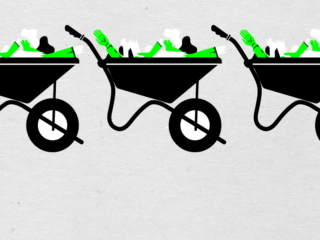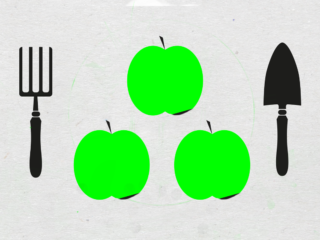Working out how much space you need to survive is easy. Just use the potato rule

It’s one of the first questions people ask us. “If we want to grow fruit and veg, how much space do we need?” It fact it was the first question we asked ourselves, back when we began our own, apocalypse-surviving vegetable garden. It isn’t an easy one to answer. But here’s one way of doing it. Use the potato rule.
This is a simple way we developed to visualize how many people a site could feed, by working out how many potatoes you could grow in it. Why potatoes? Because they’re one of the most high-calorie veg you can grow in a temperate climate – ie the kind of weather you get in the UK, and much of North America – and as they store well, they’re available to eat pretty much year round. The combination makes potatoes a useful rule-of-thumb veg when you’re assessing a site’s potential.
Imagine it’s January, and only thing you were going to eat for a whole year was chips. (Not, nutritionally speaking, that good a plan. But this is a thought-experiment, so for now we’ll let it pass.) How much space should you devote to growing potatoes to still be alive at Christmas?
Depending on what statistics you rely on – we tend to use a combination of RHS-reported yields and DEFRA’s annual agricultural figures – a square metre of soil planted with potatoes will yield somewhere between 5-7.5 kg of tubers. Based on USDA Food Data figures for raw potato, this is the equivalent of 3,850-5,775 kCals. Meanwhile British government dietary recommendations suggest the average adult should eat 2,250 kCals a day. Which all adds up to this: 1 square metre planted with potatoes can keep you alive for a maximum of two and a half days.
So, to adequately feed one average adult for one year, using only potatoes, you would need a planting area of at least 146 sq metres – about three-fifths of the average, full-size allotment. To put it another way, a standard British football pitch – 7, 200 sq metres – could keep almost 50 people fed for a year.
Beyond the potato rule
The reality is, of course, more complicated. Depending on their variety, potatoes are only in the ground for between 14 and 20 weeks, after which you clear them away. This means you can use the same space, both before and after they’re in, to grow other good and nutritional things to eat: in the UK climate that might include broad beans, cabbages, carrots, chard, beetroot, spinach, quinoa… And you don’t have to grow potatoes at all: runner beans that are left on the vine to dry are delicious – particularly the white-seeded varieties – and provide a similar amount of calories per square metre as potatoes, as well as way more protein.
Growing lots of different veg makes a quantum difference to how many people you can feed from a patch of ground. Let’s return to the standard British allotment size for a moment: back in the early 20th century, when there was a boom in turning land over to individual vegetable gardens, the belief was that 250 sq metres (10 rods in old money), planted carefully and staffed with a couple of hens or rabbits, was enough to keep a family of four adults alive and feistily kicking. In other words, just 60-odd sq metres of growing space should provide enough fruit and veg for one average adult.
Sadly, in a world where the average UK back garden is now only 14 sq metres1, even that is beyond most of us. So maybe a better way of answering that original question is this: not how much space do I need, but what can I do with the space I have?
Here’s an example: balconies. When we were writing our book, we found that London planning laws typically state that balconies on two-bed flats need to be a minimum of six square metres. Even if you set aside a third of that for moving around/sitting and staring into space as civilization crumbles, that still leaves a balcony-owner 4 sq metres: based on the potato rule, that’d give you 12 days of calories. Not much – but if you are a bit more ambitious, and grow winter as well as summer crops, you’ve got space for all of the following:
- 6 x runner beans
- 2 x strawberries
- 6 x kale
- 20 x beetroot
- 20 x onions
- 20 x carrots
- 2 x potatoes
- 24 x garlic
- 14 x swiss chard
- 4 x spring cabbage
To our minds, this is a better use of the space. You squeeze a few day’s calories out of it, but you’ll also have grown yourself a whole load of fresh, packaging-free veg, with no food miles attached. Nutritionally speaking, your balcony will have pumped out almost two weeks’ worth of iron, a month’s supply each of vitamins B6 and A, and a whopping six-month supply of vitamin C2. Plus you still get to have chips for tea – sometimes.

Tubers A tuber looks like a root, tastes like a root, but is actually a swollen section of underground stem. A potato is a tuber, a beetroot is – surprise – a root. It’s only really worth knowing this if you want to show off to other gardeners, or actively enjoy pub quizzes.

1 Horticultural Trade Association; Ipsos/MORI survey of GB adults
2 We’ve based all these calculations on the average yields, recommended planting distances and nutritional data in “Gardening for the Zombie Apocalypse” (Head of Zeus, October 2019). If you’re a fan of footnotes, it contains detailed explanations of where we sourced our figures; if you can’t access the book and would like more info about our sources and/or workings, drop us a line.










